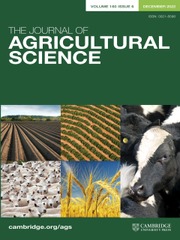Article contents
Relationships between time, temperature, daylength and development in spring barley
Published online by Cambridge University Press: 27 March 2009
Summary
The effects of sowing date on leaf appearance, spikelet initiation and mainstem apical development in spring barley cv. Triumph were investigated in field experiments involving 13 sowings made during the period 22 February to 1 July over the years 1982–1985. Delaying sowing was associated with faster rates and shorter durations of leaf appearance and spikelet initiation and earlier attainment of all stages of apex development. The rates of leaf appearance and spikelet initiation were correlated with daylength at crop emergence although there was evidence that the latter process was also influenced by temperature. The derivation of three models relating the duration of developmental phases to temperature and/or daylength is described. In these models the attainment of successive stages of apical development was assumed to require the perception by the crop of a ‘threshold amount’ (THR) of accumulated temperature (THR(ΣT)) and/or daylength (THR(ΣPT), THR(ΣP)) above certain base values (TbPb). The base values of temperature and/or daylength for each phase were derived as those values which minimized the coefficient of variation of the amounts of accumulated temperature and/or daylength experienced by all 13 sowings. For various developmental phases the model based on temperature gave base values between 0 and 3 °C. The model based on daylength gave base values between 11 and 13 h. In both these models there was a highly significant correlation between observed and expected dates of attainment of various stages of apex development. It is suggested that the derived relationships between temperature, daylength and apical development could be used as an aid in the forward planning of crop management. The model based on temperature and daylength (photothermal time) gave no useful base values and it is concluded that more precise methods of relating development to these factors must be sought.
Information
- Type
- Research Article
- Information
- Copyright
- Copyright © Cambridge University Press 1987
References
- 11
- Cited by

